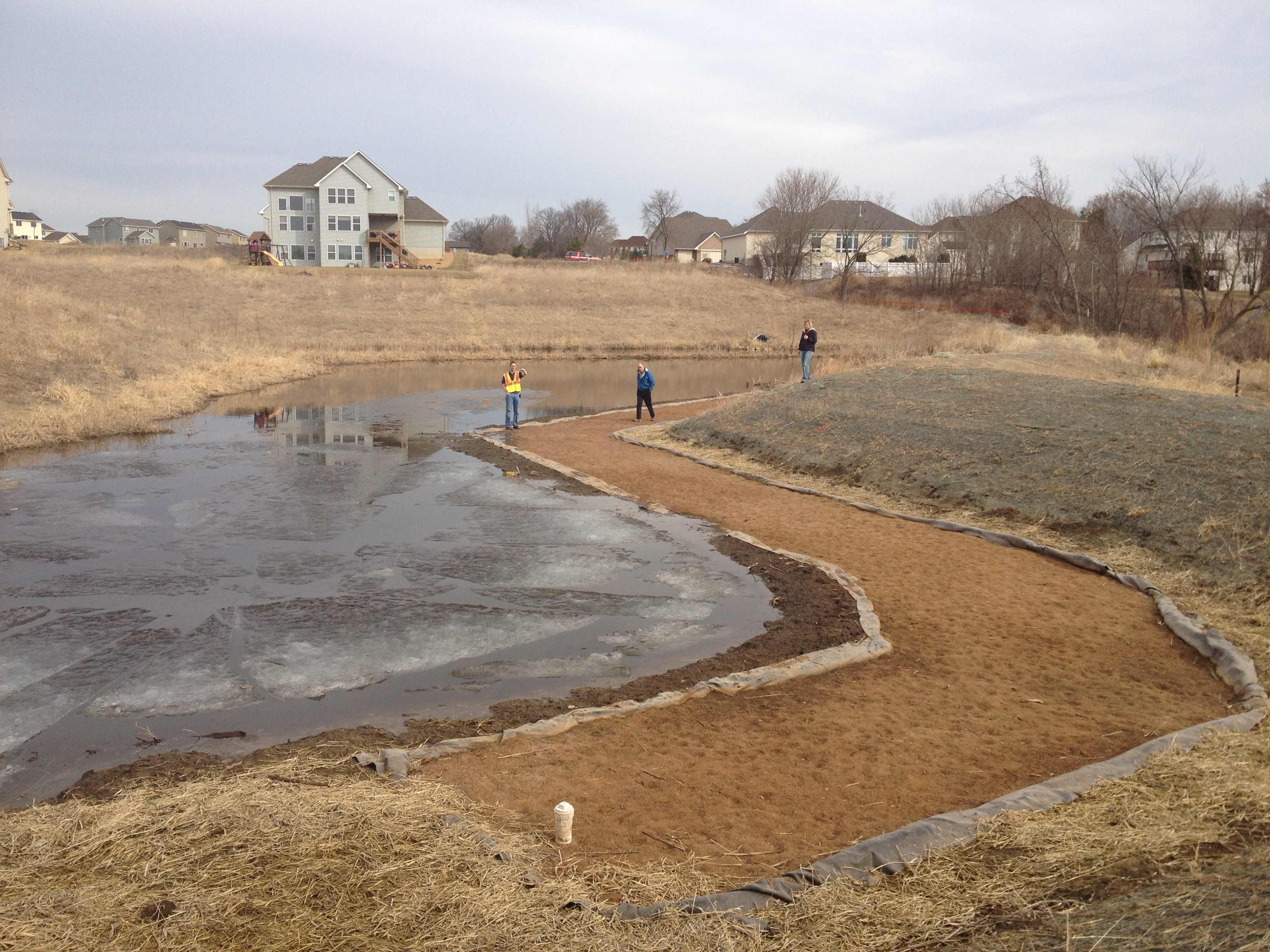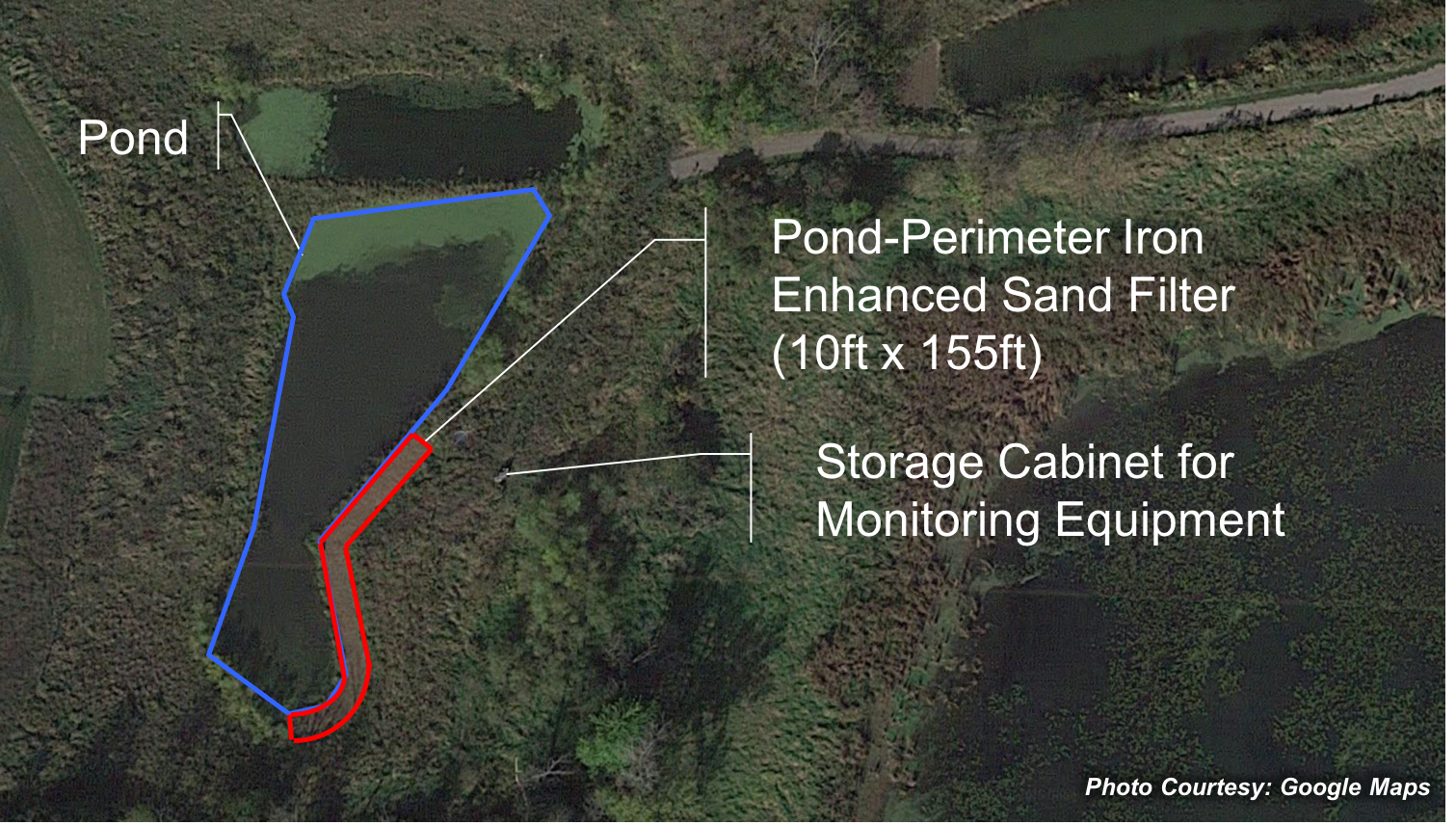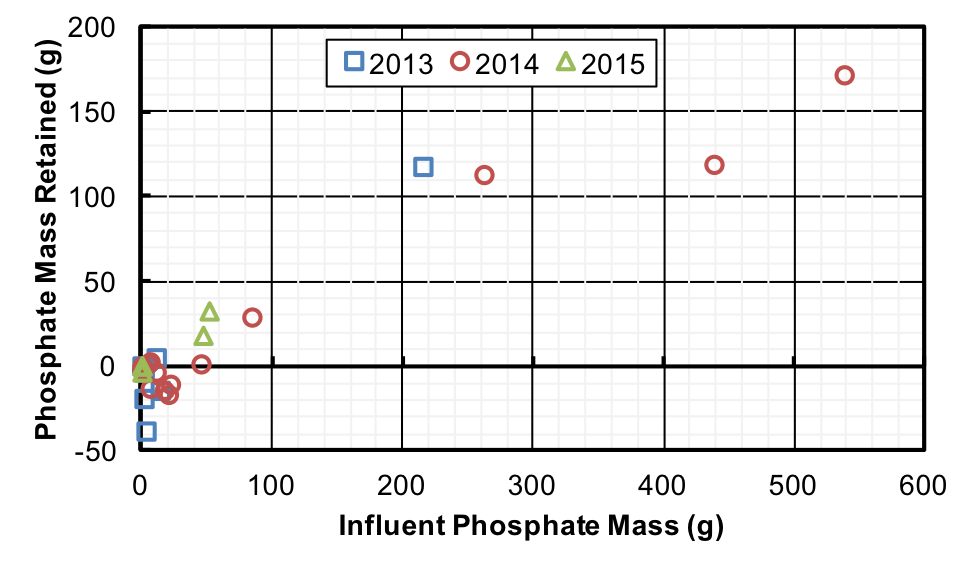
UPDATES: August 2016
Lessons Learned from Pond-Perimeter Filter Trenches
August 2016 (volume 11 - issue 3)
Contributed by Andy Erickson, Research Fellow; and John S. Gulliver, Professor, St. Anthony Falls Laboratory and the Department of Civil, Environmental, and Geo-Engineering, University of Minnesota; and Peter T. Weiss, Professor, Department of Civil Engineering, Valparaiso University.
In Collaboration with the City of Prior Lake, MN.
Funded by the Minnesota Pollution Control Agency.
Introduction
A pond-perimeter filter trench is a sand filter trench that is installed near the perimeter of a stormwater treatment wet pond (i.e., wet detention basin, retention pond), generally away from the inlet and below the normal water level (NWL) of the pond. Installing such a pond-perimeter trench can increase the capture of particles from stormwater through a combination of settling in the pond and filtration in the trench. A new NWL is set at a lower elevation within the pond, corresponding to the surface elevation of the pond-perimeter trench (see Figure 1). When stormwater (or snowmelt) runoff flows into the pond, the pond level will increase, which will cause water to flow over the surface of the sand filter and filtrate vertically downward through the media. The filtered runoff is then collected by a perforated PVC pipe drain tile and conveyed to the outlet structure (i.e., catch basin) of the wet detention basin, downstream and below the NWL control structure. For rainfall events that do not increase the water level above the water level control for the pond, all water flows through the filter media until the water surface elevation returns to the new NWL set by the filter. In large runoff events, the filter treats a portion of runoff volume while excess volume flows over the water level control and bypasses the filter. The trenches are lined with an impermeable liner such that only stormwater that has been filtered by the trench enters the drain tile and water only enters the trench through the top surface.
Figure 1. Example of a pond-perimeter shortly after construction.
All filtration practices require inspection and maintenance to remain effective and pond-perimeter filter trenches should be designed to simplify and minimize this maintenance burden. Soluble reactive phosphorus in stormwater, or phosphate, that enters stormwater ponds is often converted to particulate phosphorus as algae and aquatic vegetation. This organic material often floats at the water surface or is suspended within the water column, and may be captured by pond-perimeter filters during runoff events. If in abundance, this organic matter may reduce filtration rates. If not removed from the surface, this organic matter will biodegrade over time and may release soluble reactive phosphorus (i.e., phosphate) directly into the filter media. In addition, the biological activity within the pond could result in bacterial growth within the filter media itself, especially if the filter media remains saturated. The primary lessons we learned are 1) that it is important to design pond-perimeter filter trenches to minimize the accumulation of organic matter on the surface of the filter and limit inundation to maintain performance and reduce required maintenance, and 2) that pond-perimeter trenches may require more maintenance than traditional stormwater treatment practices over time, and simply maintaining the surface may not be enough to sustain long-term performance. The whys and hows of these lessons learned will be described in this issue of Stormwater UPDATES.
Pond-Perimeter Iron Enhanced Filter Trenches
The City of Prior Lake, MN installed several pond-perimeter filter trenches in 2010 and 2011, but enhanced these trenches with iron filings to capture phosphate that was not removed or converted within the pond. In a preliminary test (Erickson and Gulliver, 2010) of two of these pond-perimeter iron enhanced filter trenches with approximately 7.2% and 10.7% by weight iron filings, the phosphate retention varied from 28% for low inflow phosphate concentration to 86% at high inflow phosphate concentration, with an overall mean (using the pollutant load of 5 events) of 71% phosphate retention. These measurements were taken approximately six months after installation, so the filters were relatively new. The Minnesota Pollution Control Agency (MPCA) provided funding for the City of Prior Lake and the St. Anthony Falls Laboratory, University of Minnesota to monitor and assess one trench from 2013-2015 to determine phosphate retention and investigate maintenance requirements (Figure 2). The measured phosphate retention was substantially different in the most recently assessed pond-perimeter trench.
Figure 2. Site Location of Monitored Pond-Perimeter Trench Enhanced with Iron to Remove Phosphate.
As listed in Table 1, the phosphate retention was 44 g (18% of influent) in 2013 (8 events), 367 g (25%) in 2014 (15 events), and 45 g (45%) in 2015 (5 events). Half of the events (14 out of 28) were found to have negative removal (i.e., effluent mass loads > influent mass loads), but these events only contributed 5% of the influent phosphate mass and 18% of the effluent phosphate mass. These events also had low influent phosphate concentrations (3.7 – 39.4 μg/L). One possible explanation for the negative removal is the accumulation of organic phosphorus (algae and duckweed) on or within the filter media such that the degradation of this organic material (conversion of particulate phosphorus to soluble phosphate) caused an increase in the effluent phosphate concentration. Other biological processes (e.g., iron reducing bacteria in anoxic conditions) within the filter media may also have contributed to negative removal. Our measurements did not account for the conversion of particulate phosphorus to phosphate on or within the sand filter.
Table 1: Storm Event Phosphate (P) Load and Concentration.
| Year | Event | Mass P In (g) | Mass P Out (g) | Mass P Captured (g) | EMC In (µg/L) | EMC Out (µg/L) |
|---|---|---|---|---|---|---|
| 2013 | 1 | 215.9 | 98.6 | 117.2 | 125.2 | 57.2 |
| Routine Maintenance: weeded & raked | ||||||
| 2 | 3.3 | 41.6 | -38.3 | 11.7 | 147.5 | |
| 3 | 2.1 | 5.5 | -3.5 | 13.2 | 35.7 | |
| 4 | 2.3 | 22.0 | -19.7 | 11.5 | 108.3 | |
| 5 | 11.9 | 7.3 | 4.6 | 82.6 | 50.6 | |
| 6 | 1.9 | 4.0 | -2.1 | 11.5 | 24.7 | |
| 7 | 14.2 | 28.4 | -14.2 | 26.0 | 52.0 | |
| 8 | 1.2 | 0.9 | 0.2 | 32.3 | 26.4 | |
| 2013 Totals | 253 | 208 | 44 | 77.7 | 64.1 | |
| 2014 | 9 | 0.6 | 3.7 | -3.0 | 8.1 | 46.2 |
| 10 | 438.8 | 320.6 | 118.2 | 103.5 | 75.6 | |
| 11 | 85.6 | 56.8 | 28.8 | 58.5 | 38.8 | |
| 12 | 23.2 | 34.9 | -11.7 | 36.5 | 54.9 | |
| Routine Maintenance: weeded and raked | ||||||
| 13 | 0.3 | 3.1 | -2.8 | 3.8 | 41.3 | |
| 14 | 263.4 | 150.4 | 113.0 | 110.7 | 63.2 | |
| 15 | 21.4 | 39.1 | -17.7 | 39.4 | 71.9 | |
| 16 | 539.1 | 367.4 | 171.7 | 79.2 | 54.0 | |
| 17 | 46.7 | 46.3 | 0.4 | 54.5 | 54.1 | |
| 18 | 17.7 | 32.1 | -14.5 | 15.8 | 28.7 | |
| Routine Maintenance: raked algae | ||||||
| 19 | 7.2 | 21.0 | -13.8 | 10.0 | 29.2 | |
| Non-Routine Maintenance: raked, removed surface solids, broke up iron clumps | ||||||
| 20 | 11.5 | 16.0 | -4.5 | 13.7 | 19.1 | |
| 21 | 5.9 | 4.7 | 1.2 | 16.4 | 13.1 | |
| 22 | 0.7 | 0.5 | 0.1 | 17.0 | 13.4 | |
| 23 | 6.7 | 4.7 | 2.1 | 42.8 | 29.7 | |
| 2014 Totals | 1469 | 1101 | 367 | 72.3 | 54.2 | |
| 2015 | Routine Maintenance: weeded, broke up iron clumps | |||||
| 24 | 0.034 | 0.031 | 0.003 | 6.3 | 5.7 | |
| 25 | 0.9 | 4.8 | -3.9 | 3.7 | 20.0 | |
| 26 | 0.2 | 0.6 | -0.4 | 6.6 | 22.6 | |
| 27 | 47.4 | 29.3 | 18.1 | 35.6 | 22.0 | |
| 28 | 52.7 | 21.1 | 31.7 | 44.1 | 17.6 | |
| 2015 Totals | 101 | 56 | 45 | 36.2 | 19.9 | |
| Grand Totals | 1823 | 1351 | 457 | 69.1 | 51.2 | |
As shown in Figure 3, four large events (out of 28 total) each contributed over 200 g of influent phosphate (combined 80% of total influent mass) and the pond-perimeter iron-enhanced sand filtration trenches captured over 100 g from each of these storms. In total, over 520 g of phosphate were captured from these four storms alone. The remaining 24 events contributed less than 100 g each of influent phosphate, and performance varied from -38 g (negative removal) to +32 g (phosphate capture) of phosphate retained by the pond-perimeter iron-enhanced filter trenches. The combined effect of these 24 events (i.e. events with less than 200 g influent phosphate load) in terms of influent (354 g) and combined phosphate captured (-59 g of negative removal) is less than the impact of the single largest event alone (540 g influent, +172 g captured). This suggests that events with large influent phosphate loads account for the majority of the positive retention of phosphate within pond-perimeter iron-enhanced sand filtration trenches. It is also important to note that positive phosphate capture occurred for all events with an influent event mean concentrations (EMCs) greater than 40 μg/L (see Table 1).
Figure 3: Performance of Pond-Perimeter Iron Enhanced Filter Trench: Phosphate retained as a function of influent phosphate mass.
Maintenance
Maintenance has been performed on the IESF trench since installation, and maintenance performed during this project is listed in Table 1. Routine maintenance, by definition, occurs on a regular, relatively frequent schedule (Erickson et al. 2013) and for this project included inspection, weeding, raking, and breaking up iron clumps. During runoff events, water carried duckweed, algae, and other vegetation from the pond onto the filter surface. As water passed through the filter and water levels in the pond decreased, this vegetation was deposited on the filter surface. Routine maintenance activities included pulling vegetation (i.e., weeds) that were growing on the filter surface and raking the filter surface. Raking refers to disturbing the surface of the filter to a depth of 1-3” with a rigid metal rake. Sometimes, when infiltration rates had decreased, the filter would remain submerged for days. In these cases, raking was performed on the submerged filter surface. This was often enough to break through any minor surface “crust,” which increased infiltration rates so that the water level in the pond dropped to the filter surface level in a day or two. Sometimes raking was completed when the filter was not submerged. In this case the intent of raking was to break up the surface, remove any crust, and also to loosen up any vegetation growing on the surface. Raking was by far the most efficient means of removing smaller weeds from the filter surface (vs. pulling by hand). It is unclear from the data what effect routine maintenance had on the phosphate removal performance of the IESF trench, though field observations confirmed that routine maintenance preserved or restored adequate hydraulic (i.e., flow through) performance.
Non-routine maintenance occurs only as required by a change in performance, and thus occurs on an irregular, often infrequent schedule (Erickson et al. 2013). Reduction of hydraulic performance can be assessed by observation of filtration, infiltration, or other flow-based measurements, whereas water quality performance reduction can be as assessed by measuring phosphate capture by iron. When either hydraulic or water quality performance drop below acceptable levels, non-routine maintenance is needed. Non-routine maintenance, which was performed once on this iron enhanced pond-perimeter trench between January 2011 (installation) and September 2015, occurred in August 2014 in response to a decrease in filtration rate. This non-routine maintenance involved scraping and removing algae from the filter surface, removing grey muck that had developed in the filter (see Erickson et al. 2015 for more info), breaking up the sand media to a depth of several inches with metal rakes, and breaking up large clumps of iron shaving and sand conglomerates (some 12" or more in their longest dimension) with a sledgehammer. Iron-sand clumps of this size tended to be isolated, relatively deep (4-8 inches below the surface), and are less permeable. Because the large iron-sand clumps were scattered throughout the filter media, they likely have minimal impact on the hydraulic performance of the IESF trench. Iron-sand clumps, however, may reduce iron-water contact because large particles have less contact area than smaller particles. For this non-routine maintenance, two stormwater professionals each spent 2 hours on site while three hourly staff spent 8 hours each, using shovels and steel rakes to disrupt, dislodge, and remove material as described above, sledgehammers to break up large iron clumps, and buckets to transport material that was removed from the filter surface. The non-routine maintenance activities immediately improved hydraulic performance (i.e., increased filtration rates) and, after what appeared to be a rinse of the filter by the first runoff event after non-routine maintenance, improved phosphate retention as described below.
Maintenance Impact on Phosphate Retention Performance
In 2013 the effluent EMCs ranged from about 25 to 52 μg/L (except for events 2 and 4). Events in 2014 prior to non-routine maintenance had effluent EMCs ranging from 29 to 72 μg/L. The persistence of these effluent EMCs even with low influent EMC (i.e., negative removal) led to our suspicion that the filter was breaking down deposited organic material and generating phosphate in the effluent. After non-routine maintenance, the effluent EMCs of storm events in 2014 and 2015 ranged from about 6 to 23 μg/L. This lower effluent EMC range for storm events after non-routine maintenance indicates that the non-routine maintenance was successful at reducing outflow concentration. Also, phosphate retention was improved from 25% in 2014 (367 g out of 1469 g influent) to 45% (45 g out of 101 g influent) in 2015. However, the negative removals of events 20, 25 and 26 also indicate that there was still degradation of organic material and subsequent release of phosphate in the filter, which could have been due to small particles that were trapped in the filter, and not removed by non-routine maintenance.
Lessons Learned
Aquatic vegetation such as algae and duckweed is often floating at the water surface or suspended within the water column of stormwater treatment ponds, and can be captured by pond-perimeter filter trenches during runoff events. If in abundance, this organic matter can reduce flow through the trench. The organic material will also degrade and may release phosphate on and within the filter, reducing the apparent performance of the filter as a phosphate removal practice. The pond configuration and/or trench should be designed to minimize this accumulation of organic material, when possible, and limit inundation to maintain performance and reduce required maintenance. To further extend lifespan, it may be necessary to design more active management features such as inflow/outflow control, the ability to take the filter offline, and provide backflushing capabilities. Further research is needed to evaluate these possibilities.
Pond-perimeter trenches may require more maintenance than traditional stormwater treatment practices, and simply maintaining the surface may not be enough to sustain long-term performance. Maintenance should be scheduled regularly to remove material on the surface because it can substantially decrease hydraulic and treatment performance of the pond-perimeter filter trench. Non-routine maintenance may be needed to scrape and remove algae from the filter surface, remove grey muck from the top 1 – 3 inches, break up the sand media to a depth of several inches with metal rakes, and break up large clumps of iron shaving conglomerates into pebble-sized particles with a sledgehammer. After this non-routine maintenance, filtration rates and phosphate retention can be expected to increase.
Acknowledgements
The authors thank the City of Prior Lake, and specifically Pete Young, Brian Welch, and Ross Bintner, for their tireless effort while partnering on this project. We commend the City for their innovation in installed a new treatment technology in the field, and their diligence in maintaining the filter and recording the frequency and effort expended. Without the City’s staff, resources, and initiative, this project would not have happened or been completed successfully.
The full report can be referenced and found here:
Erickson, A.J., J.S. Gulliver, P.T. Weiss. (2015). Monitoring an Iron-Enhanced Sand Filter Trench for the Capture of Phosphate from Stormwater Runoff. SAFL Project Report No. 575, University of Minnesota, Minneapolis, MN, September 2015. http://hdl.handle.net/11299/175078.



